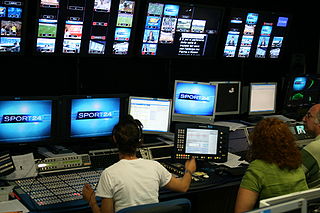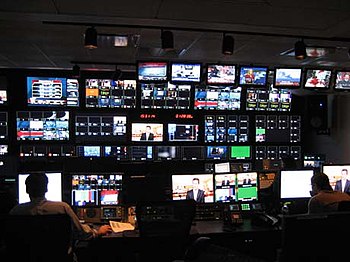
Cable television is a system of delivering television programming to consumers via radio frequency (RF) signals transmitted through coaxial cables, or in more recent systems, light pulses through fibre-optic cables. This contrasts with broadcast television, in which the television signal is transmitted over-the-air by radio waves and received by a television antenna attached to the television; or satellite television, in which the television signal is transmitted over-the-air by radio waves from a communications satellite orbiting the Earth, and received by a satellite dish antenna on the roof. FM radio programming, high-speed Internet, telephone services, and similar non-television services may also be provided through these cables. Analog television was standard in the 20th century, but since the 2000s, cable systems have been upgraded to digital cable operation.

Shortwave radio is radio transmission using radio frequencies in the shortwave bands (SW). There is no official definition of the band range, but it always includes all of the high frequency band (HF), which extends from 3 to 30 MHz ; above the medium frequency band (MF), to the bottom of the VHF band.
An automatic transmission system (ATS) is an automated system designed to keep a broadcast radio or television station's transmitter and antenna system running without direct human oversight or attention for long periods. Such systems are occasionally referred to as automated transmission systems to avoid confusion with the automatic transmission of an automobile.
Broadcast engineering or radio engineering is the field of electrical engineering, and now to some extent computer engineering and information technology, which deals with radio and television broadcasting. Audio engineering and RF engineering are also essential parts of broadcast engineering, being their own subsets of electrical engineering.
Broadcast automation incorporates the use of broadcast programming technology to automate broadcasting operations. Used either at a broadcast network, radio station or a television station, it can run a facility in the absence of a human operator. They can also run in a live assist mode when there are on-air personnel present at the master control, television studio or control room.

A television studio, also called a television production studio, is an installation room in which video productions take place, either for the production of live television and its recording onto video tape or other media such as SSDs, or for the acquisition of raw footage for post-production. The design of a studio is similar to, and derived from, movie studios, with a few amendments for the special requirements of television production. A professional television studio generally has several rooms, which are kept separate for noise and practicality reasons. These rooms are connected via 'talkback' or an intercom, and personnel will be divided among these workplaces.

The production control room (PCR) or studio control room (SCR) is the place in a television studio in which the composition of the outgoing program takes place.

A control room or operations room is a central space where a large physical facility or physically dispersed service can be monitored and controlled. It is often part of a larger command center.
KHQ-TV is a television station in Spokane, Washington, United States, affiliated with NBC. It is the flagship and namesake of the KHQ Television Group, a subsidiary of the locally based Cowles Company, which also owns The Spokesman-Review newspaper. KHQ-TV's studios are located on West Sprague Avenue in Downtown Spokane, and its transmitter is located on Krell Hill southeast of the city. The station also operates a 24-hour sports and weather channel called SWX Right Now on digital subchannel 6.2.
A television station is a set of equipment managed by a business, organisation or other entity such as an amateur television (ATV) operator, that transmits video content and audio content via radio waves directly from a transmitter on the earth's surface to any number of tuned receivers simultaneously.
This glossary of terms used in broadcasting is a list of definitions of terms and concepts related to both radio and television broadcasting, along with the industry in general.
In broadcasting, channel playout is the generation of the source signal of a radio or television channel produced by a broadcaster, coupled with the transmission of this signal for primary distribution or direct-to-audience distribution via any network. Such radio or television distribution networks include terrestrial broadcasting, cable networks, satellites, IPTV, OTT Video, point-to-point transport over managed networks or the public Internet, etc.

Globecast is a service company for the radio, television and media industry, providing solutions for media and content management, aggregation, formatting, processing, transmission and distribution. These contents are feeding various television and radio platforms: direct-broadcast satellite (DBS), digital terrestrial television (DTT), cable TV, IPTV, TV for internet connected screens, digital signage networks, cinema theaters. Globecast is a key player in this industry, serving the needs for top 100 television broadcasters in the world.
In broadcasting, local insertion is the act or capability of a broadcast television station, radio station or cable system to insert or replace part of a network feed with content unique to the local station or system. Most often this is a station identification, but is also commonly used for television or radio advertisements, or a weather or traffic report. A digital on-screen graphic, commonly a translucent watermark, may also be keyed (superimposed) with a television station ID over the network feed using a character generator using genlock. In cases where individual broadcast stations carry programs separate from those shown on the main network, this is known as regional variation or an opt-out.

In broadcast facilities and television studios, a central apparatus room, central machine room, or central equipment room (CER), or central technical area (CTA), or rack room is where shared equipment common to all technical areas is located. Some broadcast facilities have several of these rooms. It should be air-conditioned, however low-noise specifications such as acoustical treatments are optional. Equipment is connected either directly with an attached foldout monitor, keyboard and mouse or remotely via KVM switch, SSH, VNC, RS-232 or remote desktop.

A transmission control room (TCR), transmission suite, Tx room, or presentation suite is a room at broadcast facilities and television stations around the world. Compared to a master control room, it is usually smaller in size and is a scaled-down version of centralcasting. A TX room or presentation suite will be staffed 24/7 by presentation coordinators and tape operators and will be fitted out with video play-out systems often using server based broadcast automation.

An operator is a professional designation used in various industries, including broadcasting, computing, power generation and transmission, customer service, physics, and construction. Operators are day-to-day end users of systems, that may or may not be mission-critical, but are typically managed and maintained by technicians or engineers. They might also work on a 24-hour rotating shift schedule.
In terrestrial radio and television broadcasting, centralcasting refers to the use of systems automation by which customised signals for broadcast by multiple individual stations may be created at one central facility.

A television production truck or OB van is a small mobile production control room to allow filming of events and video production at locations outside a regular television studio. They are used for remote broadcasts, outside broadcasting (OB), and electronic field production (EFP). Some require a crew of as many as 30 people, with additional trucks for additional equipment as well as a satellite truck, which transmits video back to the studio by sending it up through a communications satellite using a satellite dish, which then transmits it back down to the studio. Alternatively, some production trucks include a satellite transmitter and satellite dish for this purpose in a single truck body to save space, time and cost.
Homes typically have several kinds of home wiring, including electrical wiring for lighting and power distribution, permanently installed and portable appliances, telephone, heating or ventilation system control, and increasingly for home theatre and computer networks.













